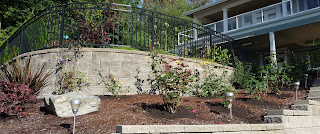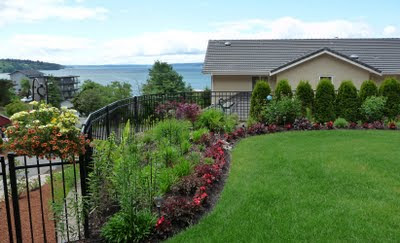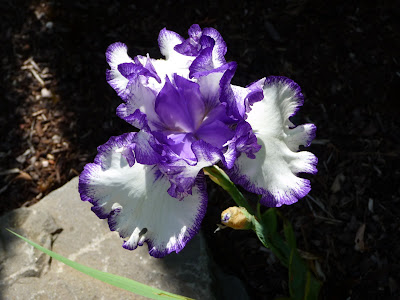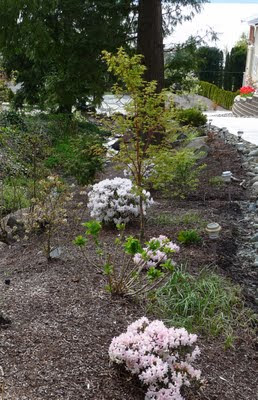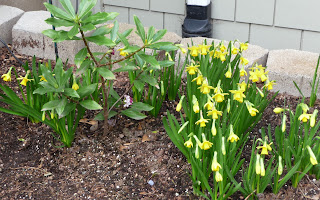Found some time in between rain showers to do some garden clean-up. Raked and picked up fallen leaves and did a little pruning. This is a good time to examine trees and shrubs for dead, damaged, or diseased branches - and to cut them off.
I also cut out some of the larger hydrangea branches (to the ground). For cane-type plants, this stimulates new growth from the ground. Heavenly bamboo (Nandina) is a good plant to prune this way. Cut down the oldest canes. New ones will form near the base of the plant.
You can see some of the evergreen plants I've added to this garden bed: Ilex crenata 'Convexa' and 'Sky Sentry' (nice Japanese holly varieties), Cephalotaxus harringtonia 'Fastigiata' (Japanese Plum Yew), Choisya ternata 'Aztec Pearl', and windmill palm. It doesn't look as bare this winter.
December 29, 2011
November 22, 2011
Fall color
These photos were taken in the middle of October, but I want to show you the fall color of some of my favorite plants. The winds in the last couple storms have blown all the leaves off now, so we have been busy cleaning up the garden beds, blowing and raking leaves and trimming up spent perennials.
Here are the Stewartia Pseudocamellia in the parking strip:
And here are the DoublefileViburnum (Viburnum plicatum tomentosum 'Mariesii') and burning bush:
Here are the Stewartia Pseudocamellia in the parking strip:
And here are the DoublefileViburnum (Viburnum plicatum tomentosum 'Mariesii') and burning bush:
Japanese-inspired garden bed
I redid my "coral bed" into a more serene and balanced garden. The Burien Master Gardeners clinic group had a great presentation about Japanese garden design, and I was inspired to show some restraint! I dug out (and transplanted elsewhere) six hardy fuchsias that were too large for this garden. I also moved out an astilbe and some columbines.
I moved in two dwarf plants that are well-suited to Japanese gardens: Ginkgo biloba 'Mariken' and a dwarf Pomegranite (Punica granatum 'Nana'). I also added several ferns.
I changed out a bronze statue for a Japanese lantern. I want to add some small stepping stones, so I can circle through the garden on the big stones and the stepping stones. (I also had to move some of the other plants a little to make room to walk through.)
It looks pretty good for late November. You can see a 'before' picture in my October 19 post.
I moved in two dwarf plants that are well-suited to Japanese gardens: Ginkgo biloba 'Mariken' and a dwarf Pomegranite (Punica granatum 'Nana'). I also added several ferns.
I changed out a bronze statue for a Japanese lantern. I want to add some small stepping stones, so I can circle through the garden on the big stones and the stepping stones. (I also had to move some of the other plants a little to make room to walk through.)
It looks pretty good for late November. You can see a 'before' picture in my October 19 post.
October 19, 2011
four yards compost!
We finished spreading compost as top-dressing for the lawn and around plants in all the garden beds. That was a lot of compost and a messy job.
I also made several trips to Starbucks for used coffee grounds and spread around the acid-loving plants before applying compost. The plants getting coffee included rhododendron, azalea, camellia, blueberry, and choisya.
I also made several trips to Starbucks for used coffee grounds and spread around the acid-loving plants before applying compost. The plants getting coffee included rhododendron, azalea, camellia, blueberry, and choisya.
October 11, 2011
Angel's Trumpet mishap
The wind blew over my largest Angel's Trumpet, and the pot broke. What a mess! So I spent a couple hours this morning cleaning it up. The plant got a good root pruning before moving into a new pot. I usually prune in the spring before bringing outside, but this plant got its roots pruned early. I cut the branches back about halfway (a little more than usual) and moved the plants into the storage room.
I'm going to think about a creative way to use the large broken pieces of pot. I've seen some interesting uses in other gardens, but I want to think of what might work well in my yard.
I'm moving things into storage. I've moved my tuberous begonias in, after letting them dry out. I will cover them with vermiculite to store for the winter.
I am going to clean the leaves of one of my elephant ears plants and replace the top layer of soil, then will move them inside the house for the winter. Hopefully, they won't bring many insects in. I will store another plant in the storage shed to see how it does over the winter.
I repotted some abutilon plants into smaller pots for overwintering. Almost time to bring them in too.
John changed the tubes in one light fixture in my storage room to full-spectrum lights. I will try to remember to turn on and off regularly to give the plants a boost.
I'm going to think about a creative way to use the large broken pieces of pot. I've seen some interesting uses in other gardens, but I want to think of what might work well in my yard.
I'm moving things into storage. I've moved my tuberous begonias in, after letting them dry out. I will cover them with vermiculite to store for the winter.
I am going to clean the leaves of one of my elephant ears plants and replace the top layer of soil, then will move them inside the house for the winter. Hopefully, they won't bring many insects in. I will store another plant in the storage shed to see how it does over the winter.
I repotted some abutilon plants into smaller pots for overwintering. Almost time to bring them in too.
John changed the tubes in one light fixture in my storage room to full-spectrum lights. I will try to remember to turn on and off regularly to give the plants a boost.
Lawn aerated and overseeded
Hooray! John did a very thorough job aerating the lawn Saturday afternoon. He went over it several times. Then he spread a mix of perennial rye and fine fescue seed and organic fertilizer. Then he top dressed with compost.
We had four yards of compost delivered. It is much less expensive than buying bags, but it sure is messy! I think we got a batch of good quality compost. I now have more than two yards left to spread around my plants throughout the yard.
Here is a photo of the lawn. It sure looks messy, so we hope the rains wash most of the compost down into the grass in the next couple weeks.
We had four yards of compost delivered. It is much less expensive than buying bags, but it sure is messy! I think we got a batch of good quality compost. I now have more than two yards left to spread around my plants throughout the yard.
Here is a photo of the lawn. It sure looks messy, so we hope the rains wash most of the compost down into the grass in the next couple weeks.
September 16, 2011
Time to start thinking about refreshing your lawn
From now until the middle of October is a great time to aerate your lawn. Aerating will help with lawn compaction and provides more air to the roots. Thatch if the layer of thatch has built up to one inch.
If you are lucky enough to have someone who comes by in your neighborhood to aerate lawns for a reasonable price, take them up on it! Otherwise, you can rent an aerator (and thatcher if needed) for a half day at your local hardware store. That's what we will do later this month.
The process to thatch and aerate:
If you are lucky enough to have someone who comes by in your neighborhood to aerate lawns for a reasonable price, take them up on it! Otherwise, you can rent an aerator (and thatcher if needed) for a half day at your local hardware store. That's what we will do later this month.
The process to thatch and aerate:
- Set the lawn mower to 3/4 inch and mow the lawn.
- Run the thatcher over the lawn once in each direction.
- Mow again at same setting.
- Run the aerator in both directions. Aerating is great for your lawn, so you can go over it multiple times.
- Wait a day for the plugs to dry out somewhat, then mow to break them up. It's not perfect but it makes it look better. Leave them on the lawn - they will work into the soil in a week or two.
- Overseed (we use a mix of perennial ryegrass and fine fescue) and fertilize (organic preferred).
- Water lightly and frequently if it doesn't rain.
Water your dry areas
We have had a long dry spell in the Pacific Northwest. Even with a few rain showers, some of your plants may be suffering. Give your plants that are not in irrigated areas a good dose of water.
Time to divide bearded iris
If your iris are crowded, divide them now. Dig up clumps, cut apart rhizones into divisions with roots and a fan of leaves. Dispose of any damaged or diseased parts. Trim the leaves as you wish for tidiness. Replant about 18" apart at a shallow depth - the same depth as before (unless your clumps were so crowded that they were out of the ground). Water well.
September 3, 2011
More watering, deadheading, and weeding!
The plants are requiring less water now. It must be the combination of more moisture in the air, shorter days, and less intense sun now that is it September. It also seems like there are fewer weeds sprouting. That's good since it is hard to get the energy up for a lot of yard work at the end of summer.
August 24, 2011
Watering with music
I have a couple areas that don't have irrigation and have not been watered all year. This hand (hose) watering takes a couple hours, as I do a deep watering very occasionally. I made this much more enjoyable by listening to music on my ipod. Why hadn't I thought of this before?
August 22, 2011
Harvesting scarlett runner beans
Ate the first beans Saturday - a little later this year. We are enjoying the beautiful screen the plants make, and watching the hummingbirds who love these plants. The hummingbirds have many flowers to feast on throughout the garden.
Recent garden activities - watering, deadheading and weeding
Most of my gardening time seems to be taken by watering pots and plants that don't get enough water from irrigation (often blocked by another plant).
I also do the occasional walk through with my action hoe to get little weeds that crop up. I usually find some larger weeds that had been hiding. Then I need to walk through the perennial beds with clippers to deadhead spent flowers and groom dried up foliage.
I also do the occasional walk through with my action hoe to get little weeds that crop up. I usually find some larger weeds that had been hiding. Then I need to walk through the perennial beds with clippers to deadhead spent flowers and groom dried up foliage.
July 24, 2011
Ginkgo biloba ‘Mariken’
A wonderful addition - a dwarf ginkgo. I've been interested in adding a ginkgo tree to my garden for a few years, but don't have the space in my full sun areas for a large tree. This dwarf ginkgo only gets to about 4 feet, so it will be a nice specimen plant to feature.
July 20, 2011
A memory garden
My mom passed away July 6, so I have been too busy to tend to my blog. I added plants to a garden bed to make a memory garden for mom. I created this garden last summer with input from mom (previously a master gardener and plant lover), so it already has many of her favorite flowers, such as alstroemeria. She loved the windmill palm, which she could see out her window. I added more perennials, including more alstroemeria and a plant called "Angel's fishing rod" (Dierama pulcherrimum). I have ordered a memorial garden stake and rock. Here are two photos of "Barbara's Memory Garden":
July - reaching the garden's peak
What a difference a month makes! I am all ready for my garden club (Marine Hills Garden Club) to come here for a potluck tonight.
I've been tidying up the garden beds: staking, deadheading spent flowers, trimming dead branches, and hoeing/pulling small weeds. I've also planted some new annuals (half price at the nursery!) and a few new perennials.
I've been tidying up the garden beds: staking, deadheading spent flowers, trimming dead branches, and hoeing/pulling small weeds. I've also planted some new annuals (half price at the nursery!) and a few new perennials.
June 22, 2011
Bright spots of color on a gray day
It is nice to see some pops of color when the sun isn't shining - too often this year! I am astounded at how large my Lady's Mantle grew (upper right of photo).
June 13, 2011
My little shade garden
It is always fun to watch my shade garden grow each spring. I have six Hosta 'Gold Standard', several Astilbe plants that bloom white and pink, and several different types of ferns, including Autumn fern, Japanese painted fern, Ostrich fern, Hart's tongue fern, Tatting fern, and Royal fern.
Staking plants with English Y-stakes
Well, plants are finally growing enough to need stakes! I used up all my Y-stakes (about 30) this week.
I also planted two flats of wax begonias ("Cocktail Vodka' - what a fun name!) as edging. I need to get one more flat to finish the border.
I also planted two flats of wax begonias ("Cocktail Vodka' - what a fun name!) as edging. I need to get one more flat to finish the border.
Hardscaping with Stones
Last week we had our favorite "excavator" guy, Noel Hess, bring and install two truckloads of 3 - 4 man rocks. He created four solid steps up to the hillside garden area. He also installed about 20 big rocks in the large berm area along our lower driveway, and he placed more on the upper berm and hillside.
This weekend we shoveled 35 yards of bark! I was pretty careful to keep away from most plants. I had put compost around many landscape plants a couple weeks ago.
Here are some photos showing the results of our work this week.
You can see the new steps on the right:
This is the "berm" next to the lower driveway:
Here are two photos of Noel at work on the steps:
This weekend we shoveled 35 yards of bark! I was pretty careful to keep away from most plants. I had put compost around many landscape plants a couple weeks ago.
Here are some photos showing the results of our work this week.
You can see the new steps on the right:
This is the "berm" next to the lower driveway:
Here are two photos of Noel at work on the steps:
June 2, 2011
Doublefile Viburnum - my favorite landscape shrub
The Doublefile Viburnum look fabulous on the hillside. In fall 2009, I started some additional ones from cuttings. These are doing well as they get well established.
These bushes look terrific in May when blooming, but they are such a lovely shape that they look nice through fall. As a bonus, in late summer the leaves turn a striking bronze.
These bushes look terrific in May when blooming, but they are such a lovely shape that they look nice through fall. As a bonus, in late summer the leaves turn a striking bronze.
Lupine
On May 20 I planted five new blue Lupine plants in the lower garden area in SW corner. I will add more later to create a bed that is striking when someone walks up my driveway. I added three more and think I will still add another five or seven.
Dutch iris
Here is a photo of the first Dutch iris to bloom in my garden this spring. It was taken May 20, which is later than usual due to our cool spring weather. Several Heuchera surround the iris in this bed near the walkway to the front door.
May 13, 2011
Clearing brush to gain access to stream
I've been clearing out some brambles and branches and other debris to gain access to the stream from the upper garden area, in the lower part of the hillside. Here is a peak at the stream from here. I added some rocks enhance it. A fun little project to work off stress!
Spreading compost
I spread compost around many of the plants on the hillside. The soil is very poor - mostly dirt from house construction that was moved to the hill. It was a blank slate four years ago, and I selected plants that would do well in clay soil on a hillside in part sun or shade. Most of the plants are native shrubs. There are also about almost 20 viburnums (double-file and tinus), which are thriving in this environment. A few rhododendron and azalea are doing fine, even though the soil is not very well-drained.
I will post a photo when the double-file viburnums get into full bloom, as I think they will be spectacular in a couple weeks.
I will post a photo when the double-file viburnums get into full bloom, as I think they will be spectacular in a couple weeks.
May 6, 2011
Container planting
It is finally time to plant your containers for summer show! Well, all except some of the more tender annuals, such as sweet potato vine (Ipomea), impatiens, and begonias. These will stay in my garage for another week.
I over-wintered non-stop begonias (in vermiculite in my storage area). In March I planted them in pots and brought most of these inside. They will stay inside for another couple weeks.
I've brought all the over-wintered plants outside, except for the angel's trumpet. I repotted several plants, such as pony-tail fern and abutilon. They just seemed to be calling out for fresh potting soil.
I over-wintered non-stop begonias (in vermiculite in my storage area). In March I planted them in pots and brought most of these inside. They will stay inside for another couple weeks.
I've brought all the over-wintered plants outside, except for the angel's trumpet. I repotted several plants, such as pony-tail fern and abutilon. They just seemed to be calling out for fresh potting soil.
Red Apeldoorn Tulips
Have you experienced frustration from tulips not coming back the second year? Try planting the Red Apeldoorn Tulip. They are readily available in the fall. I bought mine inexpensively on two different years in big bags at one of the box hardware stores. These tulips come back better each year!
They appreciate our wet fall/winter/spring weather, but don't want much water during the summer. Well, that is great for our climate!
Try planting a patch this fall!
They appreciate our wet fall/winter/spring weather, but don't want much water during the summer. Well, that is great for our climate!
Try planting a patch this fall!
Spring garden images
Here are a few photos showing parts of my garden in early May. This dogwood is just starting to bloom.
I appreciate the beautiful light green shades of new growth.
A new hanging begonia with emerging perennials behind.
Berm between the driveway and the little stream, showing some small rhododendron, blueberries, coral bark maple, vine maple, hydrangeas, evergreen huckleberry, and hebes.
A pot of tulips by the upper driveway. Even though they will not come back next year, it is worth planting for the spring show. This fall, I crowded a bag of double tulips in the pot. I planted another bag of yellow tulips in the hillside rock garden (which needs more plants!).
Today I've been clearing brush to the area on the right and behind the steps. This will give easy access to the stream. But I got into some kind of bramble that gave me a rash on my arms. Had to come inside to wash up and apply anti-itch cream. Fortunately it worked right away!
We are going to have some bigger stones set for a more solid set of steps up to the hillside. This will provide safer access to this part of the yard.
I appreciate the beautiful light green shades of new growth.
A new hanging begonia with emerging perennials behind.
Berm between the driveway and the little stream, showing some small rhododendron, blueberries, coral bark maple, vine maple, hydrangeas, evergreen huckleberry, and hebes.
A pot of tulips by the upper driveway. Even though they will not come back next year, it is worth planting for the spring show. This fall, I crowded a bag of double tulips in the pot. I planted another bag of yellow tulips in the hillside rock garden (which needs more plants!).
Today I've been clearing brush to the area on the right and behind the steps. This will give easy access to the stream. But I got into some kind of bramble that gave me a rash on my arms. Had to come inside to wash up and apply anti-itch cream. Fortunately it worked right away!
We are going to have some bigger stones set for a more solid set of steps up to the hillside. This will provide safer access to this part of the yard.
Native plants - Elderberry and Red Flowering Currant
Here is a picture of a red-flowering currant that I took last month. Yikes - I've been remiss about posting. I planted dozens of various native plants in February 2010. They came as small plants from the county conservation society, but they have grown quickly and are thriving. Most of them are not in irrigated areas, so get watered infrequently - or not at all.
This is the native elderberry. My "native" landscape areas are doing great in poor soil with almost no attention. The red-twig dogwood is another winner in dry or moist soil, and in sun or shade.
March 16, 2011
A few March garden activities
Ferns: If you have ferns and have not yet trimmed the old fronds, do it now so the new ones won't get in the way. In a few weeks, your ferns will look great. This photo shows the new fronds curled up tight (for now).
Hardy fuchsia: Trim the old wood. New growth will come from the roots, and the plant will look better in the spring and summer. This photo shows new growth coming from the bottom of one fuchsia, but most of mine don't show much new growth yet.
Hostas: Clean up any old leaves and twigs. The new growth is just beginning, and the slugs will go crazy. Use an iron phosphate slug bait, such as Sluggo, which is not harmful to animals.
Hardy fuchsia: Trim the old wood. New growth will come from the roots, and the plant will look better in the spring and summer. This photo shows new growth coming from the bottom of one fuchsia, but most of mine don't show much new growth yet.
Hostas: Clean up any old leaves and twigs. The new growth is just beginning, and the slugs will go crazy. Use an iron phosphate slug bait, such as Sluggo, which is not harmful to animals.
March 7, 2011
Pruning Roses
I worked in between rain showers and got my roses pruned (along with the roses at Foundation House). I had four or five roses that had to be replaced due to winter damage. Well, two of them were actually poor performers, because I had not bought a high enough quality plant last year. I bought four bare root plants and one potted. Hybrid Teas: two Pascali (white) and one Olympiad (red). Grandifloras: one Dick Clark (multi-colored cherry, pink, cream ) and one Gold Medal (Golden Yellow).
Planting:
I soaked the bare root rose bushes, then trimmed the roots and some of the branches (to just above outward facing buds). I mixed some compost with castings from my worm bin and soil, and I added alfalfa meal and super phosphate. This mixture went in a little mound in the bottom of the hole. I spread the roots over the mound, filled in about 2/3 of the hole, watered, and filled in the rest.
Pruning:
I removed the dead, diseased, and tiny canes (also those that faced inwards). I trimmed the remaining (generally three to five) strong canes to 1/4 inch above an outward facing bud and down to where the pith was creamy colored. Finally, I removed any old leaves and raked debris from the bed (to help prevent disease).
Planting:
I soaked the bare root rose bushes, then trimmed the roots and some of the branches (to just above outward facing buds). I mixed some compost with castings from my worm bin and soil, and I added alfalfa meal and super phosphate. This mixture went in a little mound in the bottom of the hole. I spread the roots over the mound, filled in about 2/3 of the hole, watered, and filled in the rest.
Pruning:
I removed the dead, diseased, and tiny canes (also those that faced inwards). I trimmed the remaining (generally three to five) strong canes to 1/4 inch above an outward facing bud and down to where the pith was creamy colored. Finally, I removed any old leaves and raked debris from the bed (to help prevent disease).
February 22, 2011
Grooming Hellebores
I trimmed the old leaves from my three Hellebores located in a bed near the front door. They like the small amount of morning sun they get here. Their location partially under the eaves keeps the soil from getting too soggy.
Trimming the old leaves helps prevent the Botrytis fungus. It also allows us to better see the flowers, which appear in the winter.
Trimming the old leaves helps prevent the Botrytis fungus. It also allows us to better see the flowers, which appear in the winter.
February 8, 2011
Early iris
Some of my little rock garden iris are blooming.
The Daffodil Tete-a-Tete are just starting to bloom. If you don't have any, buy some in pots in the grocery store (or nursery) to enjoy some late winter bloom. After they finish blooming, plant the bulbs in a flower bed where you would like to see them next year.
The Daffodil Tete-a-Tete are just starting to bloom. If you don't have any, buy some in pots in the grocery store (or nursery) to enjoy some late winter bloom. After they finish blooming, plant the bulbs in a flower bed where you would like to see them next year.
Subscribe to:
Posts (Atom)







